Orte / Leck in Schleswig-Holstein |
|
|
You find Leck in the extreme north western corner of Germany near the Danish border. The place is already mentioned as a settlement in documents of 13th century. Since early times it was a market place and when the North Sea reached to the "Geest"-edge (sandy uplands) it even posessed a harbour on the banks of the small river "Lecker Au". But it silted up already in the 15th century. Today only an anchor in the coat of armes reminds us of those times. |
Leck now is a small community with about 7.000 inhabitants. The local tourism organisation has developed the region arround Leck in an attractive manner.
The center of the village will not have changed substantially since the middle
of 19th century. Especially St.-Willehad-Church presents itself the way the
Nagel family knew it from church-going.
An information board explains us: "The old church in Leck is named after
St. Willehad who worked as a missionary with the Saxons and Frisians. It was
first mentioned in the 13th century, but Romanesque stylistic elements and
granit stones of the north wall prove it was built in the 12th century. [...]."
Centuries later, exactly in 1865, Fanny Henriette Wilhelmine Nagel, daughter
of the in Leck practising doctor Jens Otto Nagel, and her cousin Wilhelm
Friedrich Otto Teuthorn from Kiel got married in this church. Few years
later the thatched spire was consumed by fire but already in 1875 the tower
was rebuild with red bricks in the new gothic style.
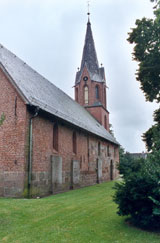 |
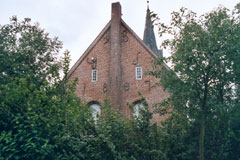 |
|
|
Total view of St.Willehad-Church (foto L1) and east gable with inscription of 1807 (foto L2). |
The nave of the romanic building presents itself with the typical mixture
of granit, soft volcanic stone (frequently imported from the Eifel region)
and red brick. This was the way small churches of Schleswig-Holstein were
mostly built because of the absence of natural stone material in this sandy
region. By the enlargement of 1807 the choir and the apsis of the old church
had disappeared.
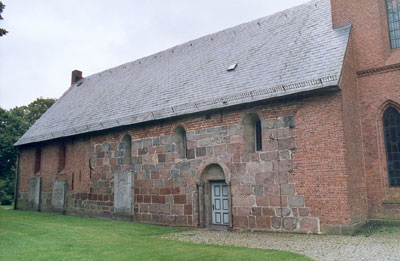
North wall of the nave with cut granit stones,
baroque memorial slabs
and romanic portal (foto L3)
When I visited the church in Summer 2002 I was impressed by the results of
restauration from 10 years ago. There is a beautiful old furnishing consisting
in beam ceiling, gallery and altar wood carving from 1520
by Master Claus Berg from Odense. But I rather appreciated the wonderful Renaissance
pulpit.
The baroque painted plates of the north gallery were completed by modern
plates from Werner Juza, illustrating parts of the Sermon on the Mount
and so repeating texts on the beams of the ceiling.
There are some peculiar objects within the church ground, i.e. stone coffins
from 12th century which were washed ashore from the North Sea. The information
board explains: "Probably before 1150 christianised immigrants from East
and West Friesland brought the custom of burying rich people (e.g. salt merchants)
in stone coffins to North Friesland. These Rhine land made coffins consisted
of sandstone from Mainz and were exported as merchandise by ship. Centuries
later, these coffins were found repeatedly in the Wadden Sea as remnants of
settlements sunk by storm tides. People then often used them as cattle troughs.
[...]."
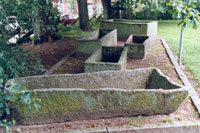
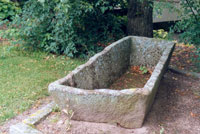
Stone coffins from 12th century, later used
as cattle troughs
(fotos L4 und L5).
Leaving the village center and following the Bahnhofstrasse (railway-station-street)
you will see the building of the now abandoned rail way station from the beginning
of the 20th century. Also some brick houses seem to be from those times.
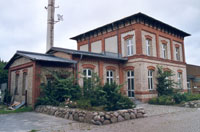
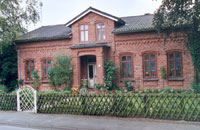
Building of today abandoned railway station
(foto L6) und red brick
house in the Bahnhofstraße (foto L7)
Reed roof covered houses of fishermen and farmers are also typical for Leck.
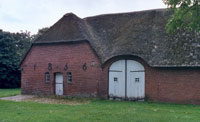
(foto L8)
© Peter Teuthorn, 10. August 2002
Leck foto gallery
http://www.leck.de
| print version |
